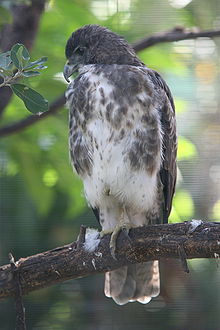Hawaiian hawk
| Hawaiian hawk | |
|---|---|
 |
|
| At Honolulu Zoo, Hawaii | |
| Scientific classification | |
| Kingdom: | Animalia |
| Phylum: | Chordata |
| Class: | Aves |
| Order: | Falconiformes (or Accipitriformes, q.v.) |
| Family: | Accipitridae |
| Genus: | Buteo |
| Species: | B. solitarius |
| Binomial name | |
|
Buteo solitarius (Peale, 1848) |
|
The Hawaiian hawk or ʻio (Buteo solitarius) is a raptor of the Buteo genus endemic to Hawaiʻi, currently restricted to the Big Island. Buteos tend to be easily recognized by their bulky bodies relative to their overall length and wingspan. The ʻio is the only hawk that is native to Hawaiʻi, and fossil evidence indicates that it inhabited the island of Hawaiʻi, Molokaʻi, Oʻahu, and Kauaʻi at one time. Today, it is known to breed only on the Big Island, in stands of native ʻōhiʻa lehua (Metrosideros polymorpha) trees. The species is protected as an endangered species in the United States. However, the IUCN classifies the species as Near Threatened.
The Hawaiian hawk measures approximately 40 to 46 centimeters (16 to 18 in) in length. The female, which weighs 605 g (21.3 oz) on average, is larger than the male, which averages 441 g (15.6 oz). Two color phases exist: a dark phase (dark brown head, breast, and underwings), and a light color phase (dark head, light breast and light underwings). Feet and legs are yellowish in adults and greenish in juveniles. During breeding season one of the pair, possibly the female, has a distinctive yellow forecap area just above the upper mandible.
Common threats to the ʻio are illegal shootings, the degradation of their native forest habitat, poisoning, vehicle collisions, starvation, and predation from other animals.
...
Wikipedia

